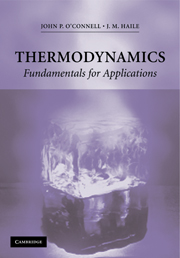Book contents
- Frontmatter
- Contents
- Preface
- Acknowledgments
- THERMODYNAMICS: Fundamental for Applications
- 0 Introduction
- PART I THE BASICS
- PART II SINGLE-PHASE SYSTEMS
- 4 Properties Relative to Ideal Gases
- 5 Properties Relative to Ideal Solutions
- 6 Relations Among Relations
- PART III MULTIPHASE AND REACTING SYSTEMS
- PART IV ENGINEERING CALCULATIONS
- APPENDICES
- Notation
- Index
5 - Properties Relative to Ideal Solutions
Published online by Cambridge University Press: 05 June 2012
- Frontmatter
- Contents
- Preface
- Acknowledgments
- THERMODYNAMICS: Fundamental for Applications
- 0 Introduction
- PART I THE BASICS
- PART II SINGLE-PHASE SYSTEMS
- 4 Properties Relative to Ideal Gases
- 5 Properties Relative to Ideal Solutions
- 6 Relations Among Relations
- PART III MULTIPHASE AND REACTING SYSTEMS
- PART IV ENGINEERING CALCULATIONS
- APPENDICES
- Notation
- Index
Summary
In Chapter 4 we used differences and ratios to relate the conceptuals of real substances to those of ideal gases. To compute values for those differences and ratios, we use the equations given in § 4.4 together with a volumetric equation of state. Such equations of state are available for many mixtures, particularly gases; however, few of those equations reliably correlate properties of condensed-phase mixtures. Although some equations of state reproduce the behavior of condensed phases of complex substances, those equations are complicated and applying them can require considerable computational skill and resources. This is particularly true when we attempt to apply equations of state to mixtures of liquids.
Therefore we seek ways for computing conceptuals of condensed phases while avoiding the need for volumetric equations of state. One way to proceed is to choose as a basis, not the ideal gas, but some other ideality that is, in some sense, “closer” to condensed phases. By “closer” we mean that changes in composition more strongly affect properties than changes in pressure or density. The basis exploited in this chapter is the ideal solution. We still use difference measures and ratio measures, but they will now refer to deviations from an ideal solution, rather than deviations from an ideal gas.
We start the development in § 5.1 by defining ideal solutions and giving expressions for computing their conceptual properties.
- Type
- Chapter
- Information
- ThermodynamicsFundamentals for Applications, pp. 184 - 227Publisher: Cambridge University PressPrint publication year: 2005



